Graduate students explore natural history on the Olympic Coast
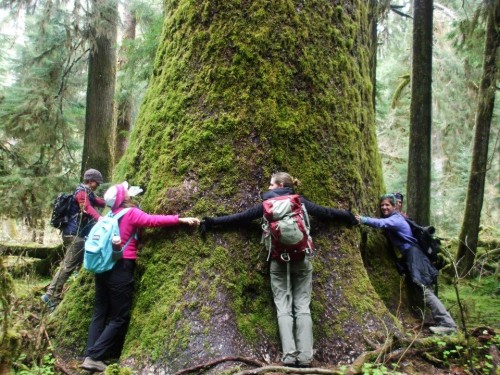
My cohort-mates have heard this a few times by now, but I’ve been to the Olympic Coast four times and despite its reputation for tempestuous weather, I’ve had blue skies each time. I must be pretty lucky. But then again, so many fortunate things happened on Cohort 12’s spring Natural History Retreat that “lucky” probably should have been the theme of the whole trip.
For one, despite arriving at the ferry terminal at the exact time the boat should have been floating away from the dock, we still somehow made it on board. This initial triumph colored our moods for the rest of the trip—we beamed as the boat sailed towards menacing rain clouds that obscured most of the high Olympic Peaks.
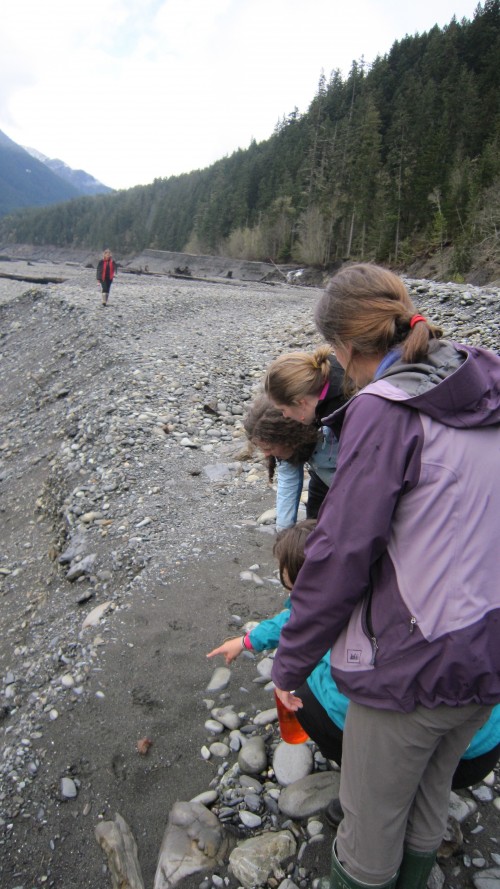 Tracking, on the shores of the Elwha. Photo by Hillary Schwirtlich
Tracking, on the shores of the Elwha. Photo by Hillary Schwirtlich
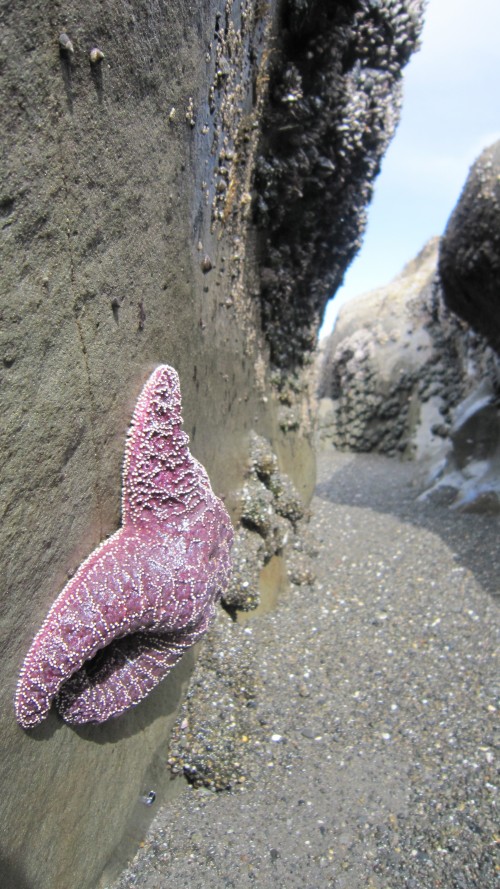 Sea Stars while tidepooling at Kalaloch. Photo by Hillary Schwirtlich
Sea Stars while tidepooling at Kalaloch. Photo by Hillary Schwirtlich
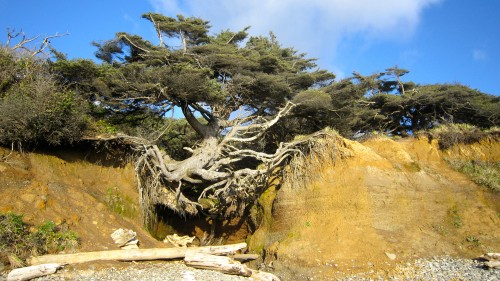 This Sitka spruce is barely holding the bank together over a small waterfall on Kalaloch Beach. Photo by Hillary Schwirtlich
This Sitka spruce is barely holding the bank together over a small waterfall on Kalaloch Beach. Photo by Hillary Schwirtlich
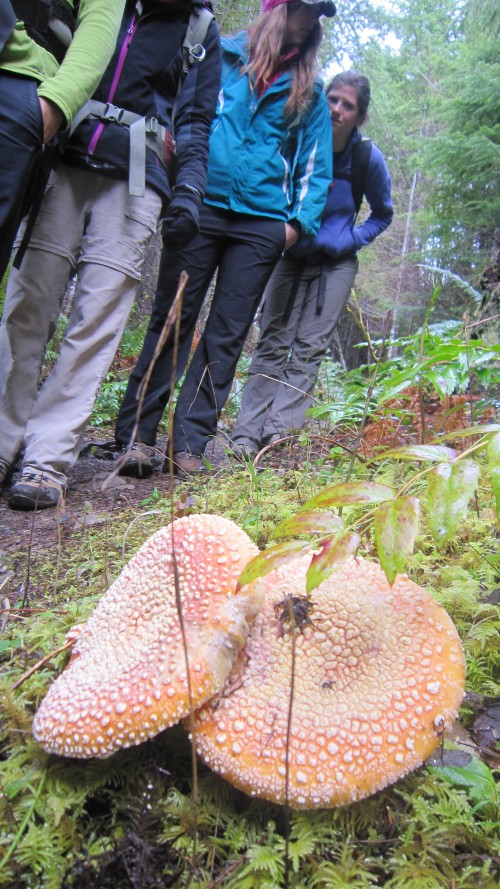 Stopping to admire the fungus. Photo by Hillary Schwirtlich
Stopping to admire the fungus. Photo by Hillary Schwirtlich
I felt lucky to be poking around and exploring without a predetermined goal. I felt like the Spring Retreat was our first real chance in months to spend an extended period of time exploring. As Mountain School instructors, we’re constantly making sure that our trail group is safe, warm, dry, fed, learning, and having fun. In our Natural History classes, though we get to learn tomes of information about the world we live in—in fun, hands-on ways—there’s always a plan set down by someone else. Rarely do we get to take control of our own time. But on this trip, we changed up the itinerary quite a bit based on what fit our fancy.
After taking a look at our choices, we chose to slide down a mudslide of a trail towards the former site of Lake Mills, the reservoir formed by the recently removed Glines Canyon Dam. A controversial topic on the Peninsula that we’ve posted about recently on Chattermarks, the removal of two dams on the Elwha River has begun to restore an estimated 70 miles of salmon habitat. The delta where the uppermost reservoir used to lay is now a bare, wide stretch of gravel on the shores of the wild Elwha, harboring little but a gushing spring feeding rust-colored algae. We watched as violet-green swallows darted along the banks of the river, catching insects whose young we caught in the spring’s water. We investigated stumps of old trees that had been logged before the reservoir began to fill. On the way back up, we noticed violets, calypso orchids, and white fawn lilies beside the trail, three things that are barely beginning to show at the Learning Center.
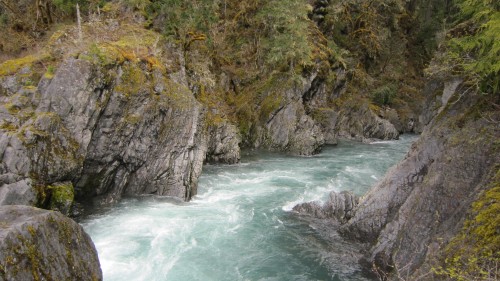 Looking down into Goblin’s Gate, a gorge on the Elwha. Photo by Hillary Schwirtlich
Looking down into Goblin’s Gate, a gorge on the Elwha. Photo by Hillary Schwirtlich
The next day, we decided to explore up the Elwha to a place called Goblin’s Gate, where all the water of the Elwha is squeezed into a space about ten to fifteen feet wide. Then, we checked out a historic cabin in Geyser Canyon (no geysers, sadly). We had lunch the final day on the blue shores of Crescent Lake. We decided to spend two nights at Kalaloch Campground on the coast because our campsite looked like a playground complete with secret rooms, climbable trees and hideaways under gnarled spruce roots. We spent some time exploring the beach and walked to nearby tidepools. We chose to spend over an hour on the shore of the Hoh River, doing art and writing group poetry while basking in the sun. We stopped to inspect a massive fallen log in the rain forest and trid to identify as many types of lichen and moss as we could.
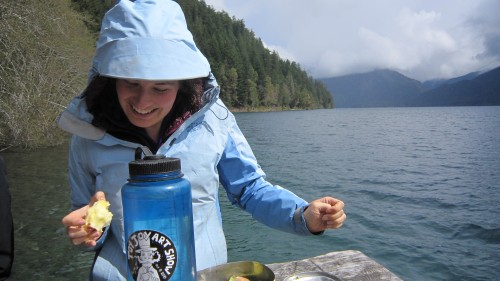 Cohort 12 student, Lindsay, dancing in her chair during lunch at Crescent Lake. Photo by Hillary Schwirtlich
Cohort 12 student, Lindsay, dancing in her chair during lunch at Crescent Lake. Photo by Hillary Schwirtlich
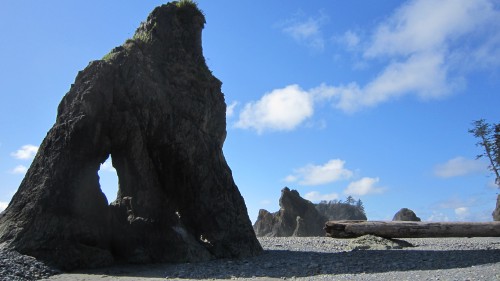 Ruby Beach – another whim of the Cohort. We saw the beach, we saw the sun, so we stopped! Photo by Hillary Schwirtlich
Ruby Beach – another whim of the Cohort. We saw the beach, we saw the sun, so we stopped! Photo by Hillary Schwirtlich
In the end, I felt so lucky to be living in such a beautiful part of the world.
As you ponder this blissful scene of previously stressed, now delighted, environmental education graduate students, I leave you with a group poem created in the Hoh Rainforest:
It’s been a while since I have seen the sun dive into the ocean in the evening.
I can almost hear the sizzling of the water as the sun dips below the horizon.
The reflection steals away light before the day fades to night.
It’s been a while since I could feel the sand between my toes
and the sun on my face at the same time.
My heart silently yearns for such a feeling and opens as I melt like snow on the peaks to find my way to the ocean again.
It’s been a while since the steady rhythm of the waves breaking on the beach have lulled me to sleep
or since my rowdy neighbors were barred owls reminding me it is spring.
It’s been a while.
But I welcome it all back like an old friend, happy to hold her close to me again
if only for a little while.
Leading photo: How many graduate students does it take to circle the circumference of a Sitka Spruce in the rainforest? Photo by Steph Bennett
Hillary Schwirtlich is a graduate student in North Cascades Institute and Western Washington University’s M.Ed. program. She grew up in South Texas, moved to the Northwest for an AmeriCorps position right out of college and fell in love with the mountains. Hillary splits her time between the group rentals and ecological studies assistant positions at North Cascades Institute.


nice story Hillary! Makes me want to go back to the peninsula right now and do some more exploring… or maybe just hit the trail with your mountain school group.
Beautiful fotos. Ruby Beach is one of my favorites, as is the whole north peninsula. Elwha gorge was interesting. Are you folks keeping up with the ecology of the area since the dams were removed. Such an interesting and moving event. Cheers for the North Cascades Institute.